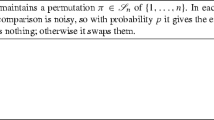Abstract
Sorting is studied in this paper as an archetypal example to explore the optimizing power of consensus. In conceptualizing the consensus sort, the classical hill-climbing method of optimization is paired with the modern notion that value and fitness can be judged by data mining. Consensus sorting is a randomized sorting algorithm which is based on randomly selecting pairs of elements within an unsorted list (expressed in this paper as a permutation), and deciding whether to swap them based on appeals to a database of other permutations. The permutations in the database are all scored via some adaptive sorting metric, and the decision to swap depends on whether the database consensus suggests a better score as a result of swapping. This uninformed search process does not require the definition of the concept of sorting, but rather depends on selecting a metric which does a good job of distinguishing a good path to the goal, a sorted list. A previous paper has shown that the ability of the algorithm to converge on the goal depends strongly on the metric which is used, and analyzed the performance of the algorithm when number of inversions was used as a metric. This paper continues by analyzing the performance of a much more efficient metric, the number of cycles in the permutation.

Similar content being viewed by others
References
Avramovic I, Richards DS (2015) Randomized sorting as a big data search algorithm. In: International conference on advances in big data analytics, ABDA ’15, pp 57–63
Estivill-Castro V, Wood D (1992) A survey of adaptive sorting algorithms. ACM Comput Surv 24(4):441–476
Flajolet P, Sedgewick R (2002) Analytic combinatorics—symbolic combinatorics. Technical report, Algorithms Project, INRIA Rocquencourt
Hashem IAT, Yaqoob I, Anuar NB, Mokhtar S, Gani A, Khan SU (2015) The rise of “big data” on cloud computing: review and open research issues. Inf Syst 47:98–115
Hays J, Efros AA (2008) Im2gps: estimating geographic information from a single image. In: IEEE conference on computer vision and pattern recognition, pp 1–8
Tian W, Zhao Y (2014) Optimized cloud resource management and scheduling. Elsevier, Amsterdam, pp 17–49
Wang H, He X, Chang MW, Song Y, White RW, Chu W (2013) Personalized ranking model adaptation for web search. In: Proceedings of the 36th international ACM SIGIR conference on research and development in information retrieval, SIGIR ’13. ACM, New York, pp 323–332. https://doi.org/10.1145/2484028.2484068
Yang D, Zhang D, Yu Z, Yu Z, Zeghlache D (2014) Sesame: mining user digital footprints for fine-grained preference-aware social media search. ACM Trans Internet Technol 14(4):28:1–28:24. https://doi.org/10.1145/2677209
Author information
Authors and Affiliations
Corresponding author
Additional information
Publisher's Note
Springer Nature remains neutral with regard to jurisdictional claims in published maps and institutional affiliations.
Rights and permissions
About this article
Cite this article
Avramovic, I., Richards, D.S. Analysis of consensus sorting via the cycle metric. J Comb Optim 44, 1831–1847 (2022). https://doi.org/10.1007/s10878-020-00553-9
Published:
Issue Date:
DOI: https://doi.org/10.1007/s10878-020-00553-9




